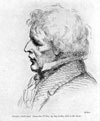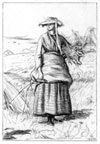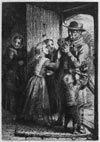|
PALMER'S
PEERS
An
Introduction to
The
Etching Club
 and and
 A
selection of etchings by fellow members of the Club A
selection of etchings by fellow members of the Club
from its early days,
till the 1850's
The Etching Club
The
Etching Club was
established by Charles West Cope in 1838. Other
early members included Thomas Creswick, Henry
James Townsend and Richard Redgrave, and later
members, c1850, in addition to Palmer, included
the Pre-Raphaelites Millais and Holman Hunt,
and even, c1870, Seymour Haden, though Haden
disagreed with the Club’s policy of pricing
plates by the number of manual hours that had gone
into their production, and resigned in 1878.
The
stormy relations that Haden raised disrupted what
had always been, till then, a friendly and sociable
group, as described by Charles West Cope -
"During
the time I resided in Russell Place, the Etching
Club, which became so well-known afterwards,
was founded. It was at first only a small society.
We met at each other's rooms in turn, once a month,
and experimented in etching for an hour or two,
and then had a simple supper, limited to bread
and cheese. This arrangement soon broke down, for
it was found that we had not conveniences, such
as proper tables and lights, and we were apt to
spill the acid and spoil table-covers etc.
...Subsequently
we etched at home, and brought impressions of
our plates to the meetings, where they were freely
criticised.
...After
a time we made a selection from the etchings
and published them privately in numbers; and
later we took up poems to illustrate.
......Our
profits were never very great, although I have
received as much as 60 for one etching. The great
attraction consisted in the pleasant meetings,
where brotherly kindness abounded, and where
pleasure was ballasted by a little business and
occasional cheques. At one time the club dined
at the King's Arms, Kensington, but latterly they
dined at each other's houses, and business was
done afterwards.
...In
time nearly all in the Etching Club became members
of the Royal Academy and their evening meals
afford a fair test of their growing prosperity;
from the modest supper of bread and cheese in lodgings
to the comfortable additions of cold meats, these
developing into dinners at an inn, and, lastly,
to sumptuous repasts in good private houses, and
even palaces, waited on by flunkies.
......Of
course, this little account of the etching club
relates to a good many years, so that from very
young men we got to be decidedly old, but yet
with some friskiness left in us."
From Reminiscences of Charles
West Cope R.A. by his son Charles Henry Cope
M.A.
Published by Richard Bentley & Son
1891
Minutes,
even if frequently rather sketchy, were kept
for each meeting of the Etching Club from 1838
to 1885, charting Club activities and ideas.
The
Club had been established for three years before
they ventured on publishing their plates as collections
presented in the large folio volumes, with which
they are most associated today. In the first
two years of its existence the Club issued, to
just a handful of subscribers, up to a dozen
small sets of etchings. These earliest plates,
identified by having the words Etching
Club etched in to their lower borders (see
etchings by Thomas
Creswick in
the exhibition, listed on the right), had only
about seven impressions taken initially of each
image. (Forty-four of these plates would be re-issued
in the Club’s Etch’d
Thoughts volume, a compilation of sixty
etchings, in 1844, leading to complaints from
a few of the very earliest foundation subscribers
that so many of the images in the new publication
duplicated those they had already acquired during
1838-9.).
Members
used a firm of commercial printers, Gad & Keningale,
to print proofs of their plates. They were given
a press by John Sheepshanks, a patron and major
print collector, which was initially installed,
and for some years following housed, at their printers
(though by 1863 it is mentioned in the Club Minutes
as being in the custodianship of James Clark Hook).
Editions from the published plates were printed
by Gad and Keningale until 1872, when
Frederick Goulding, advocate of retroussage,
took over at the instigation of Seymour Haden for
what would be the penultimate Club publication;
though already at a Club meeting in November 1858
Cope had arranged a visit and subsequent demonstration
and advice on “more
artistic” printing from Auguste Delâtre,
the leading Parisian printer of the day of artists’ plates.
Among the plates sent to Delâtre were “the
unappropriated plates on steel by Palmer”.
The
Minutes also include discussion of exhibition
of member’s etchings, at International exhibitions,
in Paris, and at the R.A.
All
the early publications were issued as bound volumes,
and mainly related to poetical texts. Like printed
books they were published in editions of up to
several hundred (though they can be difficult
to find today). The etching plates, supplied by
the Club to members, were sometimes copper and
sometimes the much harder wearing steel, which
could take many passes through the press without
deterioration.
The
Club decided on a ‘theme’ and members
produced a relevant etching. The members balloted
on the selection of etchings to be published in
each book. In that the Club supplied the etching
plates for proposed publications, they also largely
determined the format of members’ etchings.
Until about midway through the 1850’s the
standardised plates tended to be only up to 120
mm (5 inches) in their maximum dimension. From
1857 (and probably slightly earlier in practice)
this rule was relaxed.
Projects
were frequently mooted and came to nothing or
after lengthy delays changed direction. There
is a single mention on 10 March 1857 of plates
given to O’Neill, Taylor, Townsend and Hunt
for “Club portraits”. And on 10 November
1879, twenty-two years later, a series of Portraits
of Members was proposed, each to do himself, on
plates the size of Van Dyck’s Iconography.
(When Samuel Palmer conceived his own unachieved
series of etchings of ‘L’Alllegro & Il
Penseroso’, it was in the terms of plates “the
size of Turner’s Liber Studiorum”).
At the Club meeting on 28 April 1862 the Secretary
read a list of Proverbs for intended illustration – Palmer
is listed as having selected ‘make hay while
the Sun shines’…
The
Etching Club Minutes cease at the beginning of
1885, four years after Palmer’s death.
The members present were Hook, Millais, Horseley,
Calderon, O’Neill and Hodgson. And the minutes
are confined to the two words “No business”.
Earlier meetings had also sometimes had a similar
description when the evening gathering had proved
to have been purely social, but they indicate a
finality in the entry for 20 Jan 1885. The Club
had run its course and was effectively superceded
by the Society of Painter-Etchers, which Haden
had founded 1880-81.
Samuel
Palmer contributed seven plates (see Palmer
Exhibition item
nos. 2, 5, 6, 7, 8, 10, 12)
to five of the following full list of Etching
Club publications. The titles of his etchings
are specified.
The
Deserted Village of Oliver Goldsmith illustrated
by the Etching Club. London published. Printed
by Gad & Keningale for the Etching Club,
1841. (80 etchings, total edition of 220.)
(Prior
to Palmer being a member)
Songs
of Shakespeare illustrated by the Etching Club.
London published by the Royal Polytechnic Union,
1843. (17 etchings, total edition of 1500.)
(Prior
to Palmer being a member)
Etch’d
Thoughts by the Etching Club. London published
by Longman, Brown, Green and Longmans, 1844.
Printed for the Etching Club by Charles Whittingham
at the Chiswick Press and Gad and Keningale. (60
etchings, total edition of c240, the first 20 being
printed on large paper.) Each etching faced a poem,
which either had inspired the image, or which the
image brought to mind. The title page also had
an apt quotation from William Cowper’s long
blank verse “The Task”
 To
arrest the fleeting images, that fill To
arrest the fleeting images, that fill
 the mirror of the mind, and hold them fast the mirror of the mind, and hold them fast
(Prior
to Palmer being a member)
Elegy
Written in a Country Churchyard by T Gray illustrated
by the Etching Club. London published for the
Etching Club by Joseph Cundall, 1847. (28 etchings,
totoal edition 400.)
(Prior to Palmer being a
member)
L’Allegro
by John Milton illustrated by the Etching Club.
London published for the Etching Club by Joseph
Cundall, 1849. (32 etchings, total edition 300.)
(Prior
to Palmer being a member)
Songs
and Ballads of Shakespeare illustrated by the
Etching Club. London published by Longman,
Brown, Green & Longmans, 1853. (35 etchings,
including 17 re-issued from Songs of Shakespeare,
1843. Edition of 225.)
Includes Palmer's
The Vine
Etchings
for the Art Union of London by the Etching Club,
London published by the Art Union, 1857. (30
etchings. Edition of 500 - distributed to Art
Union subscribers in 1857 and 1858.)
Includes Palmer's The
Skylark,
The Sleeping
Shepherd and The
Rising Moon
A
Selection of Etchings by the Etching Club,
London published for the Etching Club by Joseph
Cundall & Thomas
Bosworth, 1865. (12 etchings. Edition of 350 – the
first 50 on large paper in a portfolio, 300 on
India paper, 4to, bound.)
Includes
Palmer's The
Weary Ploughman
Etchings
for the Art Union of London by the Etching Club,
London published by the Art Union, 1872. (20
etchings. Total edition of 450 distributed to
Art Union Subscribers in 1873 and 1874.)
Includes
Palmer's The
Morning of Life
A
Series of Twenty-One Etchings Published for the
Etching Club, London, Harry Blair Ansdell, 1879.
(Edition of 100 – of which 75 were for
sale and 25 for the Club. Printed on Japan paper,
each impression pencil signed by the artist,
presented in double mounts and issued in a portfolio;
the plates bevelled for printing and ostensibly
destroyed after printing (the plates were cancelled
with scored lines.)
Includes Palmer's The
Lonely Tower
The
Junior Etching Club
The
Junior Etching Club lasted only seven years.
It was founded by the ‘old’ Etching
Club in July 1857 for younger members and those
that favoured a less finished, more sketchy style
of etching.
Whistler
was briefly a member. Millais, though a member
of the original Etching Club, also contributed
to the two collections of etchings produced by
the Junior Etching Club -
Passages
from the Poems of Thomas Hood, illustrated by
the Junior Etching Club, published by E
Gambart 1858
Passages from Modern English poets, illustrated
by the Junior Etching Club, first published
by Day & Son at the end of December 1861, and
with later editions.
Other
than a certain relaxation in the style of etching
these publications had a not dissimilar ethos
to the earlier publications of the old Etching
Club, the etchings being accompanied by related
poems.
Bibliography
- Checklist
of Etching Club publications, production prices
and sales, 1841-1879.
- The
Etching Club Minutes and related Papers,
held at the Victoria & Albert Museum
- Andrew Frederickson: The
Etching Club of London:a taste for painters’ etchings. Article/exhibition
catalogue in the Philadelphia Museum of
Art Bulletin, Vol 92, no.388, Summer 2002,
which can be read on line
- Richard
T Godfrey: Printmaking in Britain.
(Phaidon 1978)
- Kenneth
Guichard: British Etchers 1850-1940.
(R Garton 1977)
Newly acquired etchings by members of The Etching Club will be added into this exhibition, even after it has been archived.
Return to the
top ^
|
|
Palmer's
Peers Exhibition
To
view the entire Exhibition, print-by-print,
click this link and
then follow the prints through the Gallery
by using the "next print >" and "< previous
print" navigation
buttons. Alternatively, you can select an individual
print from its thumbnail or title in the list
below.
|
|
|
|
|
Charles
West Cope
Milton's Dream of his deceased Wife
Etching,
1850 |
|
|
|
|
|
Thomas
Creswick
The Blacksmithy
Shop
Etching, 1838 |
|
|
|
|
|
Thomas
Creswick
Summer
Etching, 1839 |
|
|
|
|
|
Thomas
Creswick
The
Village Church
Etching, 1839 |
|
|
|
|
|
Thomas
Creswick
Moonlight
Etching, 1839 |
|
|
|
|
|
Thomas
Creswick
The
Overshot Mill
Etching, 1857 |
|
|
|
 |
|
William
Gale
Portrait
of William Etty
Etching, 1861 |
|
|
|
|
|
James
Clarke Hook
The
Fisherman's Goodnight
Etching, 1857 |
|
|
|
|
|
William
Holman Hunt
The
Abundance of Egypt
Etching, 1857 |
|
|
|
|
|
William
Holman Hunt
The
Desolation of Egypt
Etching, 1857 |
|
|
|
 |
|
John Everett Millais
Ruth
Etching, 1858 |
|
|
|
 |
|
John
Everett Millais
Summer Indolence
Etching, 1861 |
|
|
|
 |
|
George Bernard O'Neill
The 14th February
Etching, 1872 |
|
|
|
Three English
Etchings, c1881
A
small selection of Landscapes produced by other
artists in the year of Palmer’s death,
comprising three plates from English Etchings – A
Monthly Publication of Original Etchings by
English Artists, published by William
Reeves, Fleet Street.
The
loose leaf etchings, in a paper folder, were
prefaced by a text describing the subjects
or by appropriate poetry, somewhat in the manner
of the earlier publications of The Etching
Club.
See
also the associated exhibitions:
Poetry
Made Visible
The Complete Etchings of
Samuel Palmer
Palmer's Legacy
A selection of etchings in the British
neo-romantic pastoral tradition in the 20th and
21st centuries, from F L Griggs to Ron McBurnie.
|